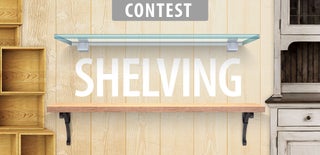Introduction: Bookshelf With a Non-Sliding Bookend
Hiya friends!
A problem I've had in my room since maybe forever is that annoying metal bookend that keeps sliding over my wooden desk. I don't need my books smacking my computer screen (right across) every now and then, so I thought up a little something that can help.
This guide will teach you how to create a bookshelf with the bookend incorporated in a way that prevents it from sliding on it's own. To do this we'll use physics (more like logical thinking). Take a look at the picture. You'll see that one end of the bookshelf is constrained to the main platform so that it won't move, whereas the other end is able to slide freely so long as you move it. Now look at the bottom of the bookshelf-- that same moving bookend serves as one of the two legs supporting it. With the load of books on the structure, the bookend itself, done right, shouldnot be able to move. This is because the bookend is functioning to keep the books in place while at the same time keep the structure upright. Because the load pushes it down, it can't move on its own. Without further ado, let's begin!
To create one of these bookshelves you're gonna need:
- 2 shorter wooden planks [10'' x 7.25'' x 0.75'']
- 1 longer wooden plank [20'' x 7.25'' x 0.75'']
- 2 wooden blocks [7.25'' x 0.625'' x 0.625'']
- Liquid Nails
- Some Standard Nails (optional, but recommended)
- Sandpaper
- Saw
- Hammer
- Chisel
- Ruler
- Pencil
- Paint, (because why not make it look nice)
Keep in mind that the dimensions I'm using are convenient for my work space, so you should measure your own desk and see what's best for you.
Step 1: Using the Sandpaper, Sand the Sides.
If you bought the planks sized, then chances are the sides are already smoothly sanded. Otherwise, you're gonna want to make sure all sides of all blocks are sanded well (splinters hurt!).
Note: Try not to curve the edges of the blocks because it could be problematic later on. Doing so gives the sliding bookend wiggle room rather than making it a little sturdier, like we want it.
Step 2: Mark the Two Smaller Planks As Shown.
With your pencil, mark the two smaller planks the way I have in red. For identification, we'll call the plank on the left with the red rectangle Plank A and the plank on the right with the red line Plank B.
Again, note that the dimensions I used may vary from yours, depending on your work space.
Make sure that the line drawn on Plank B is at approximately halfway up the red rectangle in Plank A.
This makes the two supporting legs the same length, evening out the structure (because tilted = bad).
Step 3: Plank A.
Saw into the longer side of the rectangle on Plank A, paying close attention the straight lines. Be careful not to cut too far or stray from the line, because either mishap could lead to an uneven bookend.
After you're done sawing the longer lines, take your hammer and chisel and chisel out the entire block. You're gonna want to get as close to the smaller 0.76'' line without crossing it, while at the same time making sure that the final chisel results in a line straight through.
Then, sand off the notch that you have just created.
Take one of your wooden blocks and, using the liquid nail, stick it onto either side directly above the notch, depending on which way you want the bookend to stick out (I personally stuck it on so that the bookend sticks out the back), as shown. While this dries, let's move on to Plank B.
Step 4: Plank B.
Onto Plank B. Using your liquid nail, stick Plank B onto the main platform (the longer plank). To make it as close to a 90 degree angle as you can, take second of the wooden blocks and, using the liquid nail again, stick it onto Plank B as shown. You may want to consider shimming the holes between Plank B and the main platform as I have to get a little bit closer to that perfect angle.
To stabilize the structure and keep it in place, use standard nails as you see fit. Give the liquid nail on Plank B some time to dry.
Step 5: Paint It!
Now that the bulk of the work is done, let's make it look nice!
Step 6: Test It Out!
Stick the notch on Plank A onto the main platform and slide it back and forth. Make sure that there's enough room in the notch for it to slide easily, but not so much room as to let it tilt too much. Stick several textbooks or loads onto the bookshelf and make sure that it can sustain the weights. To test the effectiveness of the sliding bookend, lean the loads onto it or try sliding it out (outwards, not upwards) gently.

Participated in the
Shelving Contest 2016









